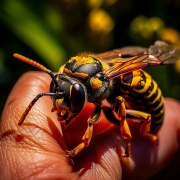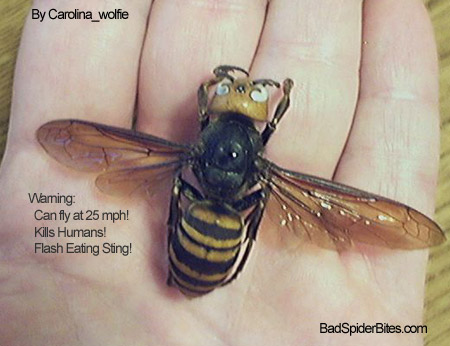Asian giant Hornet (Vespa mandarinia)
Not afraid of bees? You should! The Asian giant Hornet (Vespa mandarinia), commonly called the Sparrow Bee, is a monster with a standing record as the world’s largest Hornet! It can be as long as your pinkie and have a total wingspan (wing to wing) the length of your hand!
 Not allergic to bee Stings? It doesn’t matter with this killer! If the Hornet injects enough venom into you, you could die regardless. People stung by this giant say it’s like having a nail driven into your skin because the venom causes the arachidonic acid to be released from the phospholipid membrane disproportionately ( or, in simpler terms, it eats away at your flesh).
Not allergic to bee Stings? It doesn’t matter with this killer! If the Hornet injects enough venom into you, you could die regardless. People stung by this giant say it’s like having a nail driven into your skin because the venom causes the arachidonic acid to be released from the phospholipid membrane disproportionately ( or, in simpler terms, it eats away at your flesh).
You’ll feel this 1/4 inch stinger which is the size of the tip of your pen (think of a staple, but half the size), and because it doesn’t have ridges, the stinger can stab you multiple times – talk about a bee sting!*@
The hunt starts with this killer hornet locating a hive of honey bees; the scout then sneaks in as close as possible to its prey and sprays the area with a pheromone which serves as a road map for reinforcements.
A few Giant Hornets can slaughter a hive of 30,000 honey bees within three hours, leaving only severed heads and limbs – talk about a disadvantage!
The honey bees have to act fast, and being disadvantaged, their only hope is to trick the Hornet into entering the hive. They accomplish this by moving away from the hive and letting the Hornet believe the honey is unprotected.
Suppose the giant Hornet takes the bait and enters the hive. In that case, hundreds of honey bees hiding inside ambush the intruder covering it with their bodies and gyrating their flight muscles to generate incredible heat.
The temperature rises to 115 to 117 degrees Fahrenheit, which is tolerable for a honey bee but kills the giant Hornet (it can only handle 113 degrees). The threat is neutralized with the intruder’s death, which cannot bring reinforcements.
Think this doesn’t concern you because you’re human and don’t have honey? Think again – these giants also attack humans, and more than 40 people die each year from the attack.
Once the Hornet has you in its sights, there is no use running; it can fly up to speeds of 25 mph and travel up to 60 miles in a day, so it’s little work for the wasp to catch you and begin the onslaught of stinger stabs. I should note here that the wasp does not fly around looking for humans but is disturbed and believes it is under attack.
Are humans stealing larvae? Yep, believe it or not, Many Japanese consider the larva a delicacy and eat them deep fried or as a kind of hornet sushi. Some of the people that die each year are caught trying to steal this larva.
If this giant Hornet believes it is in danger, it will use an alarm pheromone to alert others that its nest is under attack – when that happens, you better start saying your prayers because the whole nest will mobilize and attack you in their defense! If one can kill, imagine what would happen with a nest!
What to avoid being stung by the Giant Hornet (or any other hornet)? Then avoid the following:
- Disturbing a nest (including vibrations and loud noises)
- Being within a few meters of a nest
- Disturbing or killing a hornet within a few meters of a nest
- Blocking the path of a hornet
- Breathing on the nest or Hornet
- Rapid air movements
National Geographic TV series EXPLORER had an excellent show that graphically covered this and was a fantastic video! The program was called Hornets From Hell.
You’ll see some sites claiming that the giant Hornet sprays humans in the eyes with a flesh eating chemical – not true, but it does sting with such a chemical. They are commonly located in China, India, and the mountains of Japan.


